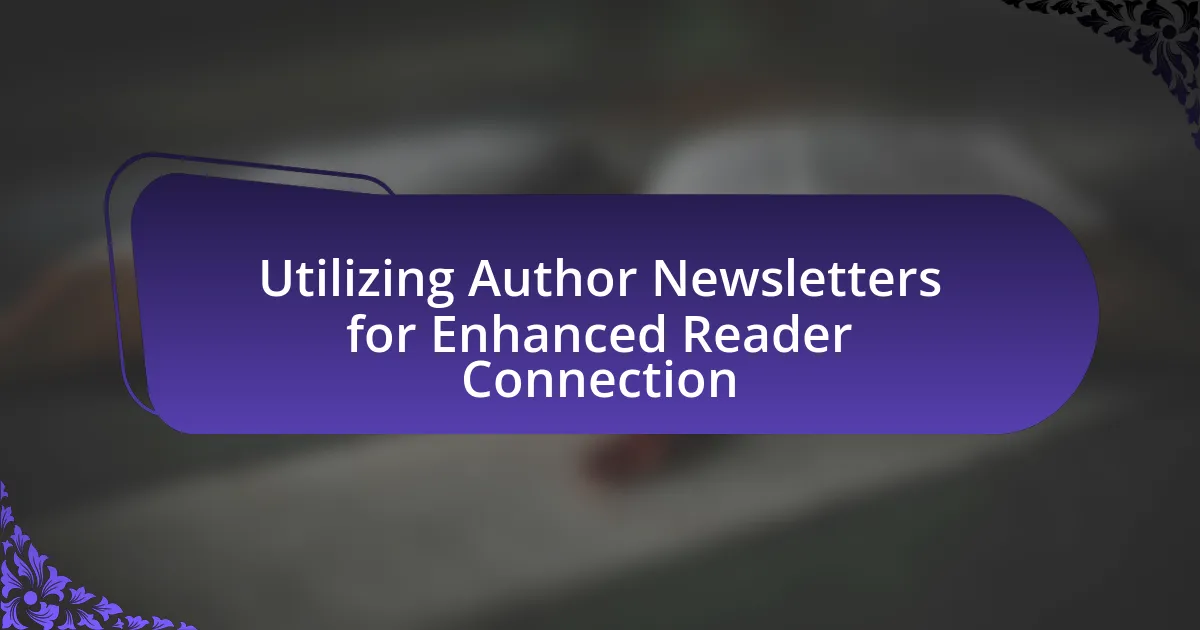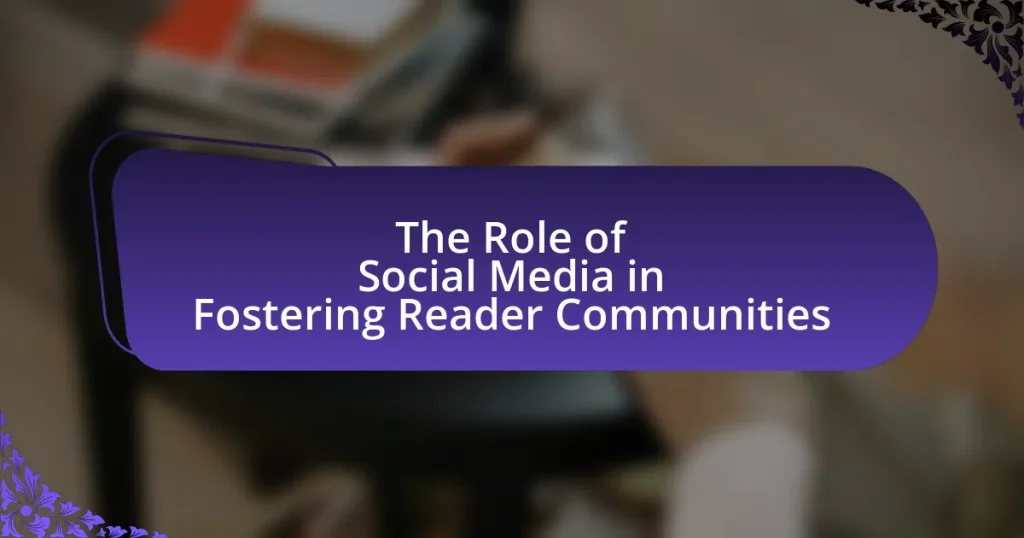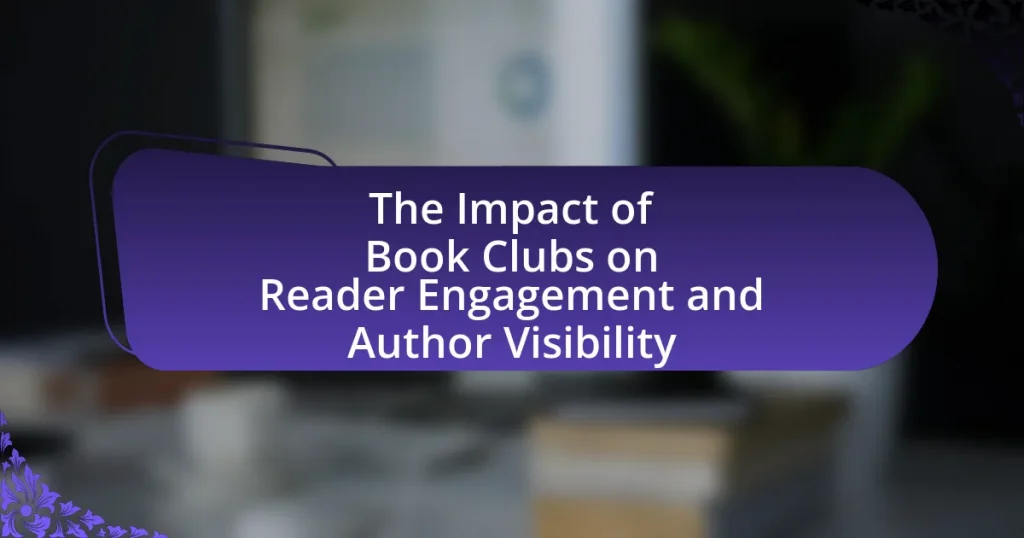Author newsletters are essential tools for authors to communicate directly with their readers, providing updates, insights, and promotional content. These newsletters foster personal connections, enhance reader loyalty, and drive book sales through personalized communication and engaging content. Key elements of effective newsletters include compelling storytelling, exclusive updates, and interactive features that encourage reader participation. Additionally, authors can utilize various platforms and strategies to grow their subscriber lists and maintain engagement, while also tracking metrics to measure effectiveness. Overall, author newsletters play a crucial role in building an author’s brand and cultivating a loyal community around their work.
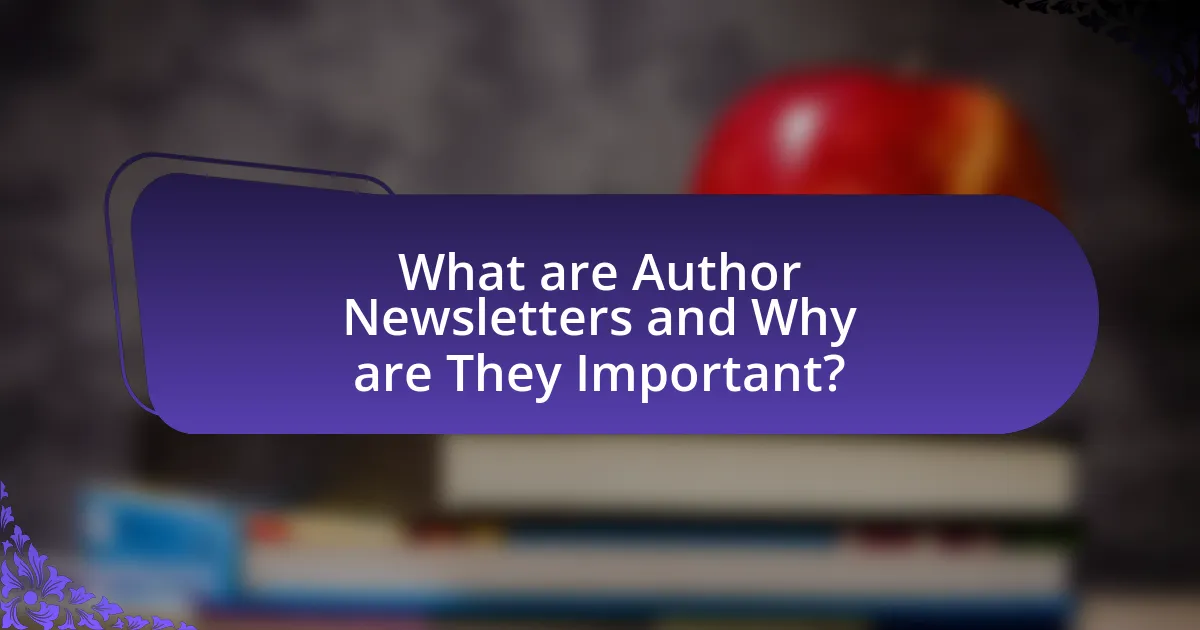
What are Author Newsletters and Why are They Important?
Author newsletters are direct communications sent by authors to their readers, typically via email, containing updates, insights, and promotional content. These newsletters are important because they foster a personal connection between authors and their audience, allowing authors to share exclusive content, announce new releases, and engage with readers on a deeper level. Research indicates that email marketing, including newsletters, has an average return on investment of $42 for every dollar spent, highlighting their effectiveness in building reader loyalty and driving book sales.
How do Author Newsletters enhance reader connection?
Author newsletters enhance reader connection by providing direct communication between authors and their audience. This format allows authors to share personal insights, updates on upcoming works, and exclusive content, fostering a sense of intimacy and engagement. Research indicates that personalized communication increases reader loyalty; for instance, a study by the Content Marketing Institute found that 70% of consumers prefer to learn about products through content rather than traditional advertising. By utilizing newsletters, authors can create a community around their work, encouraging feedback and interaction, which further strengthens the bond with their readers.
What elements make an Author Newsletter engaging for readers?
An engaging Author Newsletter includes personalized content, compelling storytelling, exclusive updates, and interactive elements. Personalized content resonates with readers by addressing their interests and preferences, making them feel valued. Compelling storytelling captivates readers, drawing them into the author’s world and creating emotional connections. Exclusive updates about upcoming books, events, or behind-the-scenes insights foster a sense of belonging and anticipation among readers. Interactive elements, such as polls or Q&A sections, encourage reader participation, enhancing engagement and community building. These elements collectively contribute to a newsletter that not only informs but also entertains and connects with readers on a deeper level.
How can personalization in newsletters improve reader relationships?
Personalization in newsletters enhances reader relationships by creating a tailored experience that resonates with individual preferences and interests. When newsletters incorporate personalized content, such as addressing readers by name and recommending articles based on past interactions, they foster a sense of connection and relevance. Research indicates that personalized emails can lead to a 29% higher open rate and a 41% higher click-through rate, demonstrating that readers are more engaged when content aligns with their specific interests. This increased engagement strengthens the bond between authors and readers, ultimately leading to improved loyalty and satisfaction.
What role do Author Newsletters play in an author’s marketing strategy?
Author newsletters play a crucial role in an author’s marketing strategy by facilitating direct communication with readers, fostering engagement, and building a loyal audience. These newsletters allow authors to share updates about new releases, events, and personal insights, which can enhance the reader’s connection to the author and their work. Research indicates that email marketing, including newsletters, has an average return on investment of $42 for every dollar spent, highlighting their effectiveness in reaching and retaining readers. Additionally, newsletters can help authors segment their audience, allowing for targeted messaging that resonates with specific reader interests, ultimately driving book sales and increasing visibility in a competitive market.
How can newsletters help in building an author brand?
Newsletters can significantly enhance an author brand by fostering direct communication with readers and creating a loyal community. By consistently delivering valuable content, authors can establish their voice and expertise, which helps in building trust and recognition among their audience. Research indicates that 81% of consumers trust information from newsletters, making them an effective tool for engagement. Furthermore, newsletters allow authors to share exclusive updates, insights, and promotions, which can lead to increased book sales and reader retention. This direct line to readers not only strengthens the author’s brand but also cultivates a sense of belonging among subscribers, reinforcing their connection to the author’s work.
What metrics should authors track to measure newsletter effectiveness?
Authors should track open rates, click-through rates, and subscriber growth to measure newsletter effectiveness. Open rates indicate the percentage of recipients who opened the newsletter, reflecting the subject line’s appeal and the audience’s interest. Click-through rates measure the percentage of readers who clicked on links within the newsletter, demonstrating engagement with the content. Subscriber growth tracks the increase in the number of subscribers over time, indicating the newsletter’s reach and popularity. According to a 2021 HubSpot report, newsletters with higher open rates (around 20-30%) and click-through rates (around 2-5%) are considered effective, providing a benchmark for authors to assess their performance.
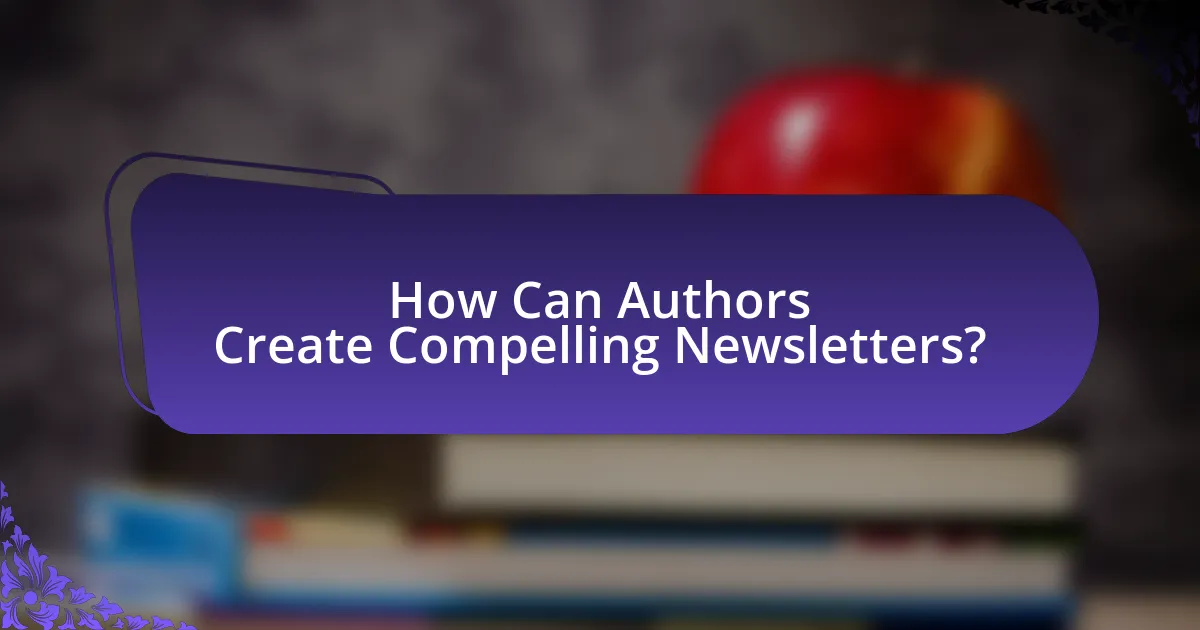
How Can Authors Create Compelling Newsletters?
Authors can create compelling newsletters by focusing on engaging content, personalized communication, and consistent branding. Engaging content includes storytelling, exclusive insights, and valuable resources that resonate with the audience’s interests. Personalized communication enhances reader connection by addressing subscribers by name and tailoring content to their preferences, which can increase open rates and engagement. Consistent branding, including visual elements and tone, reinforces the author’s identity and fosters recognition. Research indicates that newsletters with personalized content can lead to a 26% increase in open rates, demonstrating the effectiveness of these strategies in enhancing reader connection.
What content should authors include in their newsletters?
Authors should include updates on their writing projects, insights into their creative process, and exclusive content such as short stories or excerpts in their newsletters. These elements engage readers by providing them with a behind-the-scenes look at the author’s work and fostering a sense of community. Additionally, including information about upcoming events, book releases, and promotions can keep readers informed and encourage them to participate in the author’s journey. Research indicates that personalized content in newsletters can increase reader engagement by up to 50%, highlighting the importance of tailored communication in building a loyal readership.
How can authors balance promotional content with valuable information?
Authors can balance promotional content with valuable information by integrating useful insights and engaging content alongside their promotional messages. This approach ensures that readers receive both relevant information and promotional offers, fostering a sense of trust and loyalty. For instance, authors can share writing tips, industry news, or personal anecdotes that resonate with their audience, while subtly including links to their books or upcoming events. Research indicates that newsletters with a mix of content types can increase reader engagement by up to 50%, demonstrating that a well-rounded approach not only promotes products but also enriches the reader’s experience.
What types of visuals can enhance newsletter appeal?
Images, infographics, and videos can significantly enhance newsletter appeal. Images capture attention and evoke emotions, making content more relatable. Infographics present complex information in a visually engaging manner, improving comprehension and retention. Videos add a dynamic element, allowing for storytelling that can deepen reader engagement. Research indicates that articles with visuals receive 94% more views than those without, highlighting the importance of incorporating diverse visual elements to attract and retain readers.
How often should authors send newsletters to their readers?
Authors should send newsletters to their readers at least once a month. This frequency helps maintain engagement without overwhelming the audience. Research indicates that monthly newsletters can lead to higher open rates and reader retention, as they provide consistent updates while allowing readers to anticipate content. According to a study by the Content Marketing Institute, 78% of marketers who prioritize consistent communication see improved audience engagement, reinforcing the effectiveness of a monthly schedule.
What factors influence the ideal frequency of newsletter distribution?
The ideal frequency of newsletter distribution is influenced by audience engagement, content quality, and industry standards. Audience engagement metrics, such as open rates and click-through rates, indicate how often subscribers wish to receive updates; for instance, a high engagement rate may suggest a preference for weekly newsletters, while lower engagement may necessitate a bi-weekly or monthly schedule. Content quality also plays a crucial role; if the content is consistently valuable and relevant, subscribers are more likely to appreciate frequent updates. Additionally, industry standards vary; for example, in the publishing sector, authors often find success with monthly newsletters, aligning with reader expectations. These factors collectively guide authors in determining the most effective distribution frequency for their newsletters.
How can authors avoid overwhelming their subscribers with too many emails?
Authors can avoid overwhelming their subscribers with too many emails by establishing a consistent and manageable email schedule. By sending newsletters at regular intervals, such as bi-weekly or monthly, authors can ensure that subscribers receive valuable content without feeling inundated. Research indicates that email frequency significantly impacts subscriber engagement; for instance, a study by HubSpot found that sending emails too frequently can lead to higher unsubscribe rates, with 78% of consumers stating they would unsubscribe due to excessive emails. Therefore, authors should prioritize quality over quantity, focusing on delivering meaningful updates, exclusive content, or special offers that resonate with their audience.

What Tools and Platforms Can Authors Use for Newsletters?
Authors can use tools and platforms such as Mailchimp, Substack, and ConvertKit for newsletters. Mailchimp offers customizable templates and analytics, making it suitable for authors looking to track engagement. Substack allows authors to monetize their newsletters directly through subscriptions, providing a straightforward platform for content distribution. ConvertKit focuses on automation and audience segmentation, enabling authors to tailor their messages effectively. These platforms are widely recognized in the industry for their user-friendly interfaces and robust features, making them ideal choices for authors aiming to enhance reader connection through newsletters.
What are the best email marketing platforms for authors?
The best email marketing platforms for authors are Mailchimp, ConvertKit, and Sendinblue. Mailchimp offers user-friendly templates and automation features, making it ideal for authors who want to create visually appealing newsletters without extensive technical knowledge. ConvertKit specializes in serving creators, providing advanced segmentation and tagging options that help authors target specific reader groups effectively. Sendinblue combines email marketing with SMS campaigns, allowing authors to reach their audience through multiple channels, which can enhance engagement. These platforms are widely recognized for their effectiveness in building and maintaining reader connections, as evidenced by their popularity among authors and content creators.
How do different platforms compare in terms of features and pricing?
Different platforms for author newsletters, such as Mailchimp, Substack, and ConvertKit, vary significantly in features and pricing. Mailchimp offers a free tier with basic features, while its paid plans start at $13 per month, providing advanced analytics and automation tools. Substack is free for authors, taking a 10% cut from paid subscriptions, which allows for easy monetization of newsletters. ConvertKit starts at $15 per month, focusing on creators with features like landing pages and email automation. These pricing structures reflect the varying levels of service and target audiences, with Mailchimp catering to businesses, Substack focusing on individual creators, and ConvertKit appealing to professional content creators.
What integrations should authors look for in a newsletter platform?
Authors should look for integrations with email marketing tools, social media platforms, and analytics services in a newsletter platform. Email marketing tools like Mailchimp or ConvertKit enable efficient list management and automated campaigns, enhancing communication with readers. Social media integrations allow authors to share newsletter content directly on platforms like Facebook and Twitter, increasing visibility and engagement. Analytics services, such as Google Analytics, provide insights into reader behavior and engagement metrics, helping authors refine their strategies. These integrations collectively enhance the effectiveness of newsletters in connecting with readers.
How can authors effectively grow their newsletter subscriber list?
Authors can effectively grow their newsletter subscriber list by offering valuable content and incentives that appeal to their target audience. For instance, providing exclusive content such as free e-books, writing tips, or behind-the-scenes insights can attract potential subscribers. Research indicates that 70% of consumers prefer to receive promotional content through email, highlighting the effectiveness of newsletters as a marketing tool. Additionally, authors can utilize social media platforms to promote their newsletters, leveraging their existing follower base to drive sign-ups. Implementing sign-up forms on their websites and blogs can also facilitate easy access for interested readers, further enhancing subscriber growth.
What strategies can authors use to encourage sign-ups?
Authors can encourage sign-ups by offering exclusive content, such as free chapters, behind-the-scenes insights, or special promotions. This strategy creates a sense of value for potential subscribers, making them more likely to join the mailing list. Research indicates that 70% of consumers prefer to receive promotional content through email, highlighting the effectiveness of newsletters as a communication tool. Additionally, authors can utilize social media platforms to promote their newsletters, leveraging their existing audience to drive sign-ups. Engaging calls-to-action, such as “Join my newsletter for exclusive updates,” can further enhance the likelihood of sign-ups.
How can social media be leveraged to increase newsletter subscriptions?
Social media can be leveraged to increase newsletter subscriptions by promoting exclusive content and engaging directly with potential subscribers. By sharing snippets of newsletter content, authors can entice followers with valuable insights, encouraging them to subscribe for full access. For instance, a study by HubSpot found that social media posts that include a call-to-action for newsletter sign-ups can increase conversion rates by up to 6 times. Additionally, utilizing targeted ads on platforms like Facebook and Instagram can reach specific demographics, further enhancing subscription rates.
What are some best practices for maintaining reader engagement?
To maintain reader engagement, authors should consistently provide valuable content, personalize communication, and encourage interaction. Consistent delivery of relevant information keeps readers informed and interested, while personalization, such as addressing readers by name and tailoring content to their preferences, fosters a deeper connection. Encouraging interaction through questions, polls, or feedback requests invites readers to participate actively, enhancing their investment in the content. Research indicates that personalized emails can lead to a 29% higher open rate and a 41% higher click-through rate, demonstrating the effectiveness of these practices in engaging readers.
How can authors solicit feedback from their newsletter subscribers?
Authors can solicit feedback from their newsletter subscribers by including direct questions or surveys within their newsletters. This approach encourages subscribers to share their thoughts on content, preferences, and overall engagement. For instance, authors can use tools like Google Forms or SurveyMonkey to create simple surveys that can be linked in the newsletter, making it easy for subscribers to respond. Research indicates that personalized requests for feedback can increase response rates, as seen in a study by the Nielsen Norman Group, which found that targeted questions yield higher engagement.
What techniques can authors use to keep content fresh and interesting?
Authors can keep content fresh and interesting by incorporating diverse formats, engaging storytelling techniques, and interactive elements. Utilizing various formats such as videos, podcasts, and infographics can cater to different audience preferences, enhancing engagement. Engaging storytelling techniques, like cliffhangers or character development, maintain reader interest by creating emotional connections. Additionally, incorporating interactive elements, such as polls or Q&A sessions, fosters reader participation and feedback, making the content more dynamic. These methods are supported by research indicating that varied content formats and interactive features significantly increase reader engagement and retention rates.
What common challenges do authors face with newsletters?
Authors commonly face challenges with newsletters, including maintaining consistent content, growing subscriber lists, and ensuring high engagement rates. Consistency is crucial, as irregular updates can lead to decreased reader interest and higher unsubscribe rates. Growing subscriber lists is often difficult due to competition and the need for effective marketing strategies to attract new readers. Additionally, authors struggle with engagement, as crafting compelling content that resonates with their audience is essential for retaining subscribers and fostering a loyal community. These challenges are supported by industry surveys indicating that over 60% of authors report difficulties in maintaining subscriber interest and engagement.
How can authors overcome low open and click-through rates?
Authors can overcome low open and click-through rates by optimizing their subject lines and content relevance. Research indicates that personalized subject lines can increase open rates by 26%, as they create a sense of connection and urgency for the reader. Additionally, segmenting the audience based on interests and previous interactions allows authors to tailor content, making it more appealing and relevant, which can lead to higher engagement. Implementing A/B testing on subject lines and content formats further enables authors to identify what resonates best with their audience, thereby improving overall performance metrics.
What should authors do if they experience high unsubscribe rates?
Authors should analyze the reasons behind high unsubscribe rates by reviewing feedback and engagement metrics. This analysis helps identify content that may not resonate with readers, allowing authors to adjust their newsletters accordingly. For instance, a study by Mailchimp found that personalized content can increase engagement rates, suggesting that tailoring newsletters to reader preferences can reduce unsubscribe rates. Additionally, authors should consider segmenting their audience to send more targeted content, which has been shown to improve retention and satisfaction among subscribers.
What are the key takeaways for authors looking to enhance reader connection through newsletters?
Authors can enhance reader connection through newsletters by personalizing content, engaging with readers, and providing exclusive insights. Personalization involves addressing readers by name and tailoring content to their interests, which fosters a sense of belonging. Engaging with readers through interactive elements, such as polls or Q&A sections, encourages participation and builds community. Providing exclusive insights, such as behind-the-scenes looks at the writing process or early access to new works, creates value for subscribers and strengthens their connection to the author. These strategies are supported by research indicating that personalized communication increases reader engagement and loyalty.
